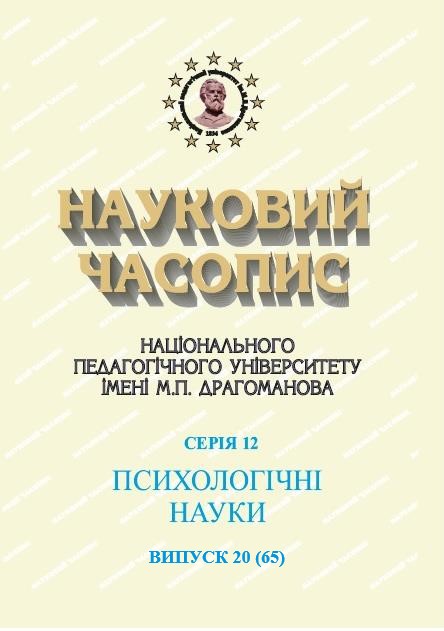STUDY OF THE INTENSITY AND TYPES OF VIOLENCE IN THE FAMILIES OF MILITARY SERVICEMEN
DOI:
https://doi.org/10.31392/NPU-nc.series12.2022.20(65).03Keywords:
violence, physical violence, psychological violence, economic violence, sexual violence.Abstract
The article analyzes the psychological factors and types of violence, their impact on relationships in servicemen’s families. The theoretical analysis of sources shows that the most typical delayed responses to stress are irritability, aggressiveness, nervousness, inability to relax, tremors, increased reactivity, anxiety, apathy, depression and pessimism, sleep disturbances, nightmares, memory loss, poor concentration, preoccupation with memories of war, fear, suspicion, destructive personality changes. The results of a survey of intimate partners of military personnel are presented, and the types of violence they encountered and their subjective intensity are identified. The survey results of violence types in the servicemen families and their subjective level are presented. Intimate partners of servicemen were selected as respondents. Based on the results obtained, interviews were conducted with intimate partners who suffered from violence. The main purpose of the interviews was to determine the probability of an increase in the subjective intensity of violence after the outbreak of a full-scale war in Ukraine. The results. It has been empirically determined that 38.1% of people who have been in a relationship with military personnel have experienced intimate partner violence. It has been established that psychological violence is the most common type of violence (38.1%), and women are more likely to be victims (33.33% of 38.1%). The results of interviews with respondents who have experienced violence showed that 23.8% of people noted an increase in the violence intensity committed against them since the beginning of the full-scale war. Conclusions. It has been established that violence in Ukrainian families is one of the most widespread social problems, as more than a third of respondents have experienced it. Based on the survey and interview data, recommendations for violence prevention were developed. At the same time, the provided recommendations can be used as self-help in situations of committed or possible violence and in cases where the individual does not have the opportunity to seek qualified help.
References
- Herman, D. (2015). Psykholohichna travma ta shliakhy do vyduzhannia: naslidky nasylstva – vid znushchan u simi do politychnoho teroru [Psychological trauma and paths to the point of view: the traces of violence - in the mind of the sim’s to political terror]. Lviv : View of Old Lion [in Ukrainian].
- Pavlish, S.O. (2010). Problema nasylstva v ukrainskykh simiakh. Sotsiolohichne opytuvannia [The problem of violence in Ukrainian families. Sociological experience].O. Pavlish (Ed.) Zaporizhzhya : View of Drukarska svіt [in Ukrainian].
- Predmestnikov, O.G. (2008). Nasylstvo v simi yak zlochyn: prychyny, vyiavlennia i rozsliduvannia. Taktykopsykholohichni osnovy [Violence in the family as a crime: causes, detection and investigation.Tacty-psychological bases]. Kherson : Aylant Publishing House [in Ukrainian].
- Garcia-Moreno, Henrika, J., Ellsberg, M., Heise, L., & Watts, C. (2006). Prevalence of intimate partner violence. Findings from the WHO multi-country study on women’s health and domestic violence. Lancet, 368(9543), 1260–1269. https://doi.org/10.1016/S0140-6736(06)69523-8
- Marshall, A.D., Panuzio, J., & Taft, C.T. (2005). Intimate partner violence among military veterans and active duty servicemen. Clinical Psychology Review, 25(7), 862–876.
- Plümper, T., & Eric, N. (2006). The unequal burden of war: The effect of armed conflict on the gender gap in life expectancy. International Organization, 60(3), 723–754.
- Saile, R., Neuner, F., Ertl, V., & Catani, C. (2013). Prevalence and predictors of partner violence against women in the aftermath of war: A survey among couples in Northern Uganda. Social Science & Medicine, 86(1), 17–25. https://doi.org/10.1016/j.socscimed.2013.02.046
- World Health Organization. (2014). Violence against women. Intimate partner and sexual violence against women. Intimate partner and sexual violence have serious short- and long-term physical, mental and sexual and reproductive health problems for survivors. Fact sheet. Geneva, Switzerland : Author. Retrieved from https://www.who.int/news-room/fact-sheets/detail/violence-against-women

